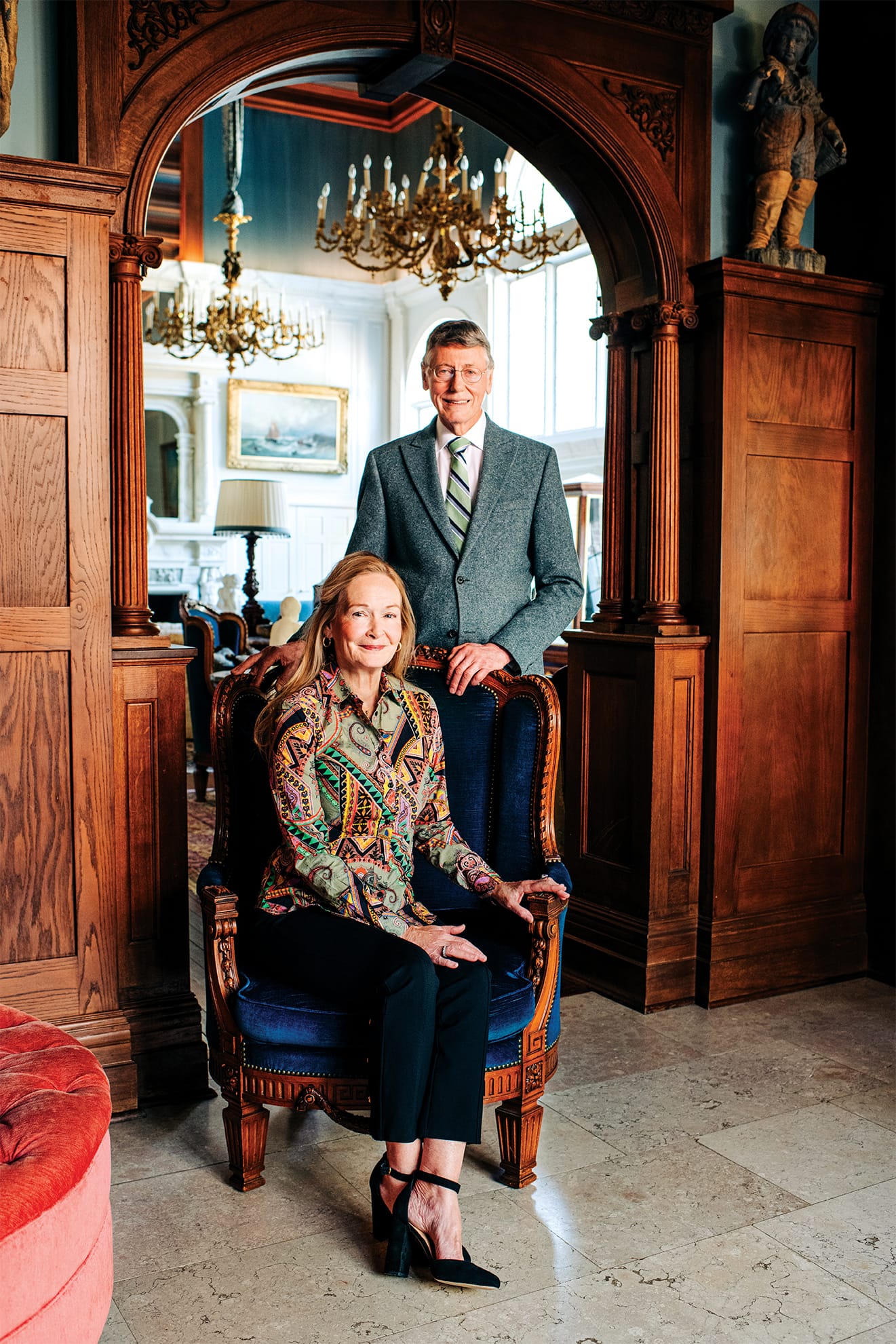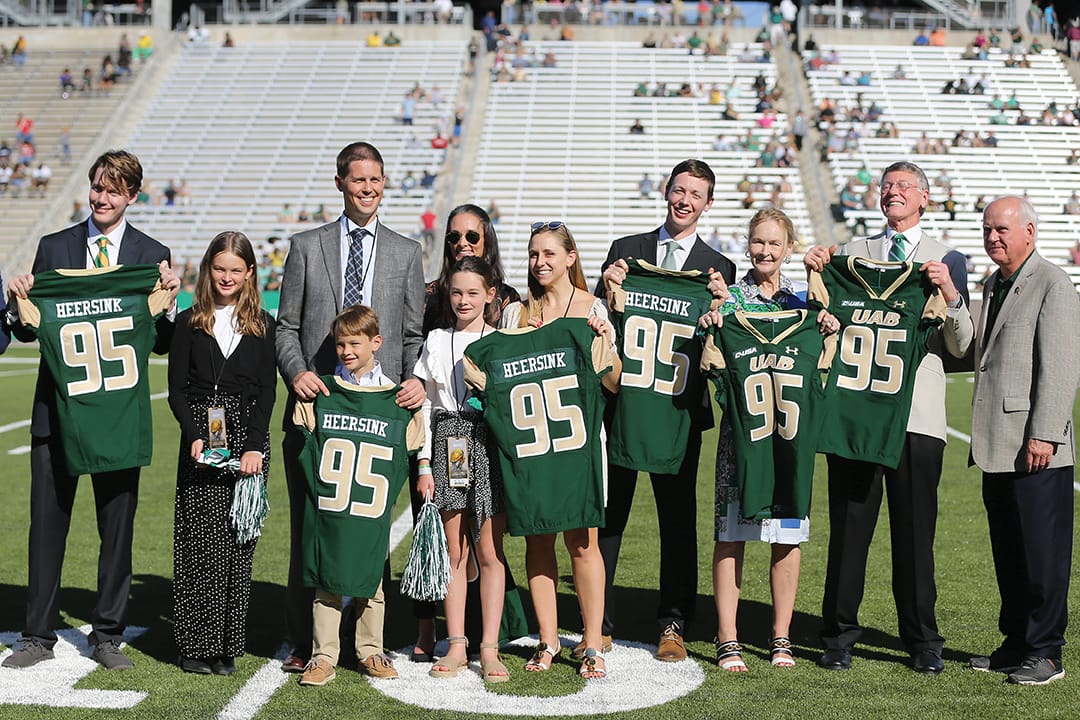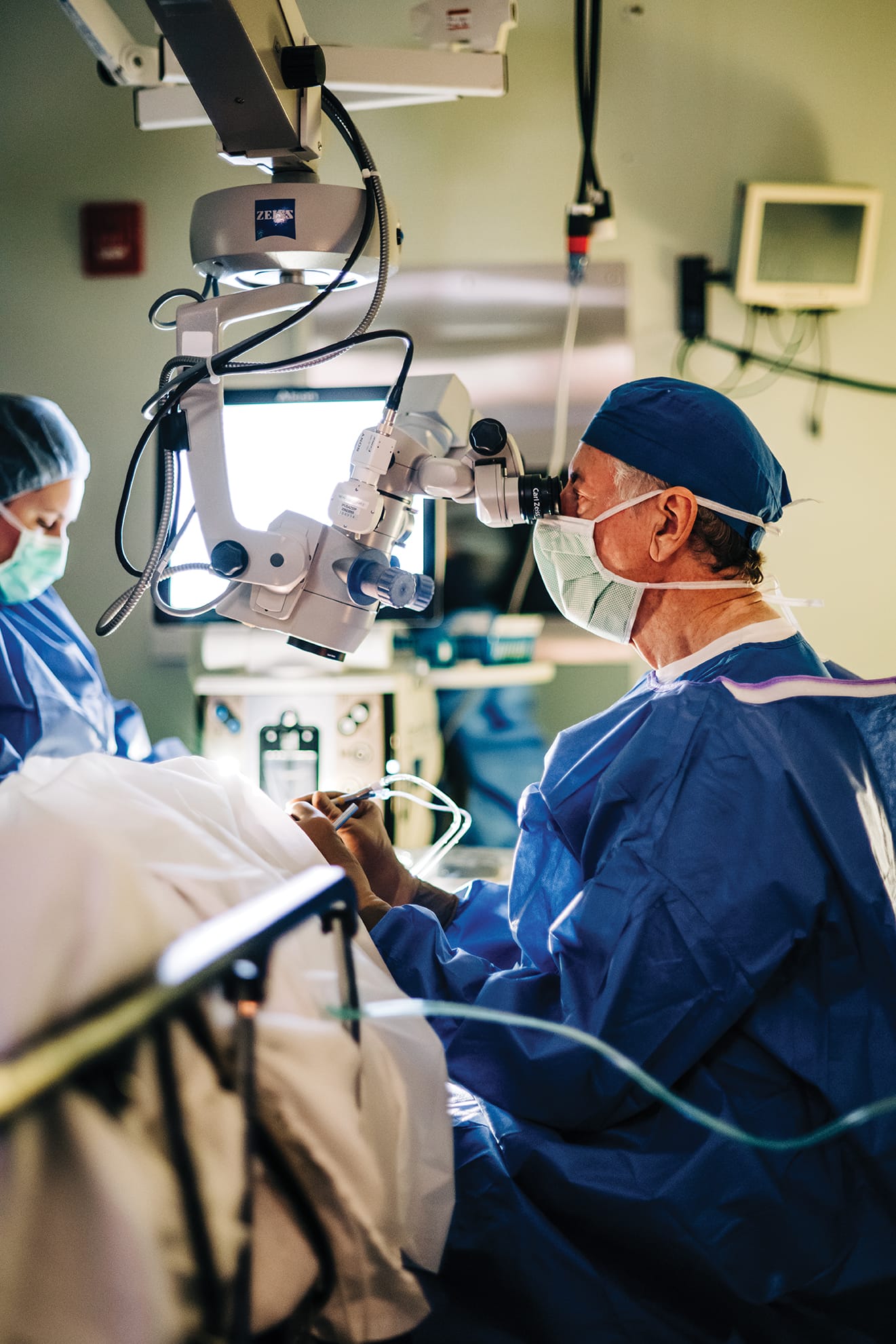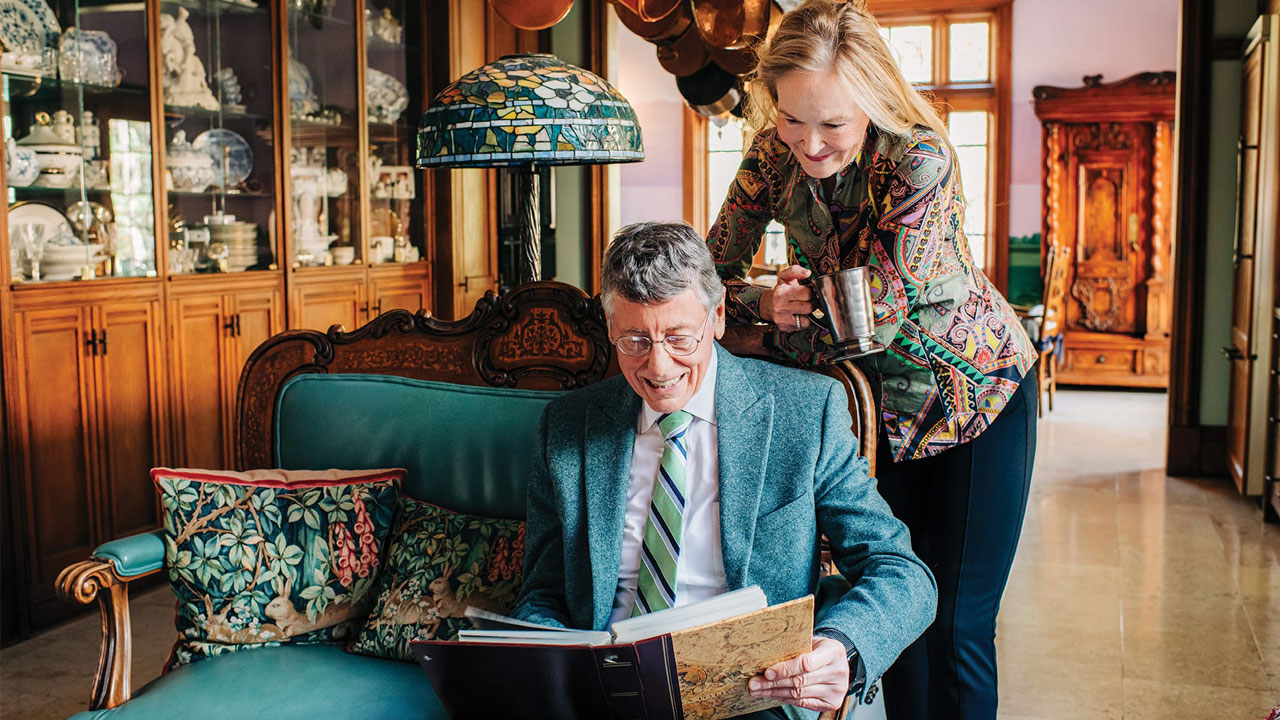Marnix Heersink, M.D., doesn’t mince words when it comes to the responsibility that UAB, and specifically the newly named UAB Marnix E. Heersink School of Medicine, carry in the coming years. Many thousands of Alabamians struggle with chronic health conditions that not only impact their own health and lifespans, but ripple out into their families, their communities, our educational system, and our economy. Two years of the COVID-19 pandemic has exacerbated many of these issues—including disparities in health outcomes between white and minority communities, a lack of access to diagnostics and therapeutics, and the financial crises many of our patients and students face—making the situation more urgent than ever.
Marnix and his wife Mary Heersink understand the hurdles we face in our state. Longtime residents of Dothan, Alabama, Heersink opened Eye Center South (now with 12 locations in three states) and Health Center South, a multidisciplinary medical complex for doctors in the Wiregrass. After more than four decades of treating patients in their home community, the Heersinks have come to know the needs first-hand. “I think Alabama can use help here,” Marnix says.
Helping is something that is hard-wired into the Heersink family code, and both Marnix’s and Mary’s fathers were hugely influential in shaping their values. Marnix was born in the Netherlands, where his father was the town mayor when Marnix was a child. As an adolescent, Marnix struggled to articulate his ideas for a future career, but his father provided critical guidance. “My dad was a very wise man,” Marnix says. “He said, ‘Tell me what you don’t want to be.’” Reframing the question helped Marnix eliminate what wasn’t important so he could identify what was: helping others. That clarity led Marnix to include medicine on the list of professions. “But my father believed in service,” Marnix says. “Not just medical service.” The important thing was to put others first, whatever the field.

Mary Parks’ father was a prominent ophthalmologist in Washington, D.C. Marshall Parks is regarded today as the “father of pediatric ophthalmology,” and Mary says the line between her dad’s work and the life of their family was blurred, since his office was attached to their house and patients and other physicians were constantly in and out. “I grew up with the idea of medicine being an all-encompassing, sacred trust.”
Marnix’s family emigrated to Canada in 1952, where his father was vice consul of the Netherlands. Marnix attended medical school at the University of Western Ontario and finished an internship at the Royal Victoria Hospital in Montreal. He landed a residency in ophthalmology at Philadelphia’s Wills Eye Hospital, and it was in Philadelphia where he met Mary. After the couple married and traveled the country to find a home, they landed in Dothan in 1978. “We came with a used car and just our clothes and a lot of hope and love,” Marnix says. “We both had great educations and were well-trained. Dothan welcomed us with open arms and Southern hospitality. We were accepted and appreciated.”
As a leading ophthalmologist in the state, Marnix was very familiar with UAB’s clinical and research expertise. But the Heersink family’s connections to UAB extend beyond the School of Medicine and Health System. As each of the six Heersink children matriculated through high school, UAB was included on the list of universities to which they applied. “Our daughter Mila was accepted into [UAB’s] Early Medical School Acceptance Program,” Mary says. “She was also accepted into three Ivy League schools plus Rice and Wellesley, but we realized it made sense to come to UAB. She would have a better quality of life, she would able to do other things, and it would give her a foundation to go to med school. She was so happy to be already accepted to med school at age 17.”
The Early Medical School Acceptance Program, led by longtime director and philosophy professor Gregory Pence, Ph.D., was just one of the benefits UAB offered to the high-achieving Heersink children, all of whom chose to attend UAB except for son Sebastian, who got his B.S. from MIT and his medical degree from Georgetown. Son Bayne received a dentistry degree from the UAB School of Dentistry; son Damion, a patent attorney, received both a B.A. in philosophy and a master’s in public health from UAB and is now training to become a physician in New Orleans; and twins Christiaan and Marius, who also were accepted into the EMSAP program and received M.D./MBA degrees from UAB, are in their respective ophthalmology and family-practice residencies. Even the Heersinks’ daughter-in-law, Juanita Titrud Heersink, was Ms. UAB in 2003, graduated from the School of Medicine, and completed her internal medicine residency at UAB.
The Heersinks say that, over the course of the many years their children came through UAB, much has changed—but much has remained the same. “When our daughter arrived at UAB, she was immediately embraced and brought into campus life,” Mary recalls. “She was intellectually so stimulated and challenged and felt so privileged to be there. We are very grateful for her initial experience, and our other children were able to build on that.”
Growing in the Right Ways
At the time Mila enrolled, UAB looked very different than it does now. “When we were first introduced to campus, it seemed very urban. It was a lot of concrete,” Mary says. “The departments were very focused and very strong educationally, and that hasn’t changed. But what we have noticed very dramatically is that today the campus is much more student-centric, green, welcoming, and diverse. It has grown in all the right ways.”
Marnix agrees. “The buildings back then were nothing compared to what we have now,” he says. “Today we have new residences coming up with exciting new designs and opportunities for people. It is beautiful here, for students and visitors and families, and that’s important. You have to consider what it looks like for someone coming in. Hats off to UAB for making this a priority.”
It’s UAB’s growth, and the strong leadership that has catalyzed it, that helped inspire the Heersinks to make their transformative $95 million gift, which was amplified by an additional $5 million from Triton Health System. The Heersinks saw vast potential in UAB and felt great confidence in President Ray L. Watts, M.D., and Selwyn Vickers, M.D., FACS, dean of the UAB Heersink School of Medicine and CEO of the UAB Health System.
Mary’s position on the School of Medicine’s Board of Visitors has also given her a unique perspective into not only the medical school’s priorities, but how the many programs and faculty members across UAB collaborate. “UAB has done a good job of getting [itself] poised to be a real leader,” Mary says. “The university has been focused on bringing students from all over the world, has maintained its very strong emphasis on the sciences and also bringing other disciplines to mix with one another so they’re not being siloed. The question really is, ‘How do you engage all these people in this thing called education?’”
“I see what Dr. Vickers is doing in the School of Medicine, and I see that he is positioning the medical school to meet so many challenges,” she continues. “UAB is a force for interdisciplinary study and cross-pollinating and germinating new ideas. And it’s so important to have undergraduate programs, including the humanities, to empower that.”
Sebastian adds that, while interdisciplinary study is critical to UAB’s success, the quality of the individual programs is in itself a key asset. “One of UAB’s great strengths is actually the strength of the other schools and programs outside of the School of Medicine,” he says. “It’s not just that UAB has them and can create interdisciplinary opportunities, but that they are such strong programs on their own. That’s what makes the connections so much more valuable.”
 President Ray Watts presents the Heersink family with commermorative jerseys at a UAB Football Game.
President Ray Watts presents the Heersink family with commermorative jerseys at a UAB Football Game.
Moved to Give
The Heersinks had all of this in mind as they pondered their $95 million investment in UAB, the largest gift in the history of the institution. “Our gift was to the School of Medicine with the intention that some of the funds will inspire other parts of the university,” Marnix says. “I’m specifically thinking of innovation and collaboration. In the future, I can see a student who is curious, but who might not be a researcher or medical student, but wants an opportunity as a non-scientist to listen, talk, and give background so scientists can think, ‘Oh I didn’t think about that, you’re telling me about a part of the world I know nothing about.’ An engineering, philosophy, or English student. We’re better off [as an institution] because we are talking to each other rather than being in silos. I love that when people can exchange and listen to others, new things happen.”
Mary agrees: “As you know, these great ideas, these big questions are coming from young people. Most breakthroughs happen before someone turns 30. They can make a huge impact in the field they’re in, whether that’s music or arts or physics. That’s another reason the gift is focused on youth and education.”
Only a small handful of U.S. medical schools are named by philanthropic gifts, and some of them are among of the most elite in the nation: the Northwestern University Feinberg School of Medicine, the David Geffen School of Medicine at UCLA, the Perelman School of Medicine at the University of Pennsylvania, the University of Chicago Pritzker School of Medicine, and the Weill Cornell School of Medicine. According to “The Chronicle of Higher Education,” the Heersinks’ gift to the UAB School of Medicine is one of the top 200 private gifts made to higher education since 2017.
For many years, the Heersinks have given generously to a number of organizations across Alabama. At UAB, they have previously established the Heersink Family Endowed Glaucoma Fellowship, the Heersink Family Foundation Scholarship Endowment in Optometry, and the Heersink Family Active Learning Resource Center in the School of Medicine’s Volker Hall, where they have also provided funds to renovate the atrium.

“There are a lot of great institutions out there,” Marnix says, “but we live in Alabama. We have come to appreciate and see we can make a difference here. This gift came from investments I’ve made over the years, and we want to put our money back into the community that trusted us. Community is the reason we are able to give to UAB. As I’m getting older my outlook on life is broader: If I had a way to change other people’s lives, why wouldn’t I?”
Fueling Innovation, Finding Solutions
The Heersinks’ gift to the School of Medicine is designed to make a broad impact. Within key focus areas, including precision medicine and pharmacogenomics, pulmonology, oncology, neurology, health disparities, immunology, and others, the gift is designed to expand patient care, medical training, and research programs and platforms. Priority initiatives, such as the recruitment and retention of faculty leaders, will be supported by the largest portion of the gift. The remainder will fund two new institutes: the Marnix E. Heersink Institute for Biomedical Innovation and the Mary Heersink Institute for Global Health, an area in which Mary is renowned worldwide as a food safety advocate and published author.
Under the guidance of Dean Vickers, the Heersinks’ vision for transformative, innovative health care will be made manifest. For example, in the Marnix E. Heersink Institute of Biomedical Innovation, there will be something called The Clinic at UAB. Director Rubin Pillay, M.D., Ph.D., says that The Clinic will be “the equivalent of an innovation center.” Here, Pillay says, doctors, nurses, and staff with ideas and solutions can work with his team to help bring their ideas to fruition. The Heersinks’ gift will also fund a satellite location, The Clinic at Dothan, to catalyze problem solving in the southern part of the state.
In the coming years, as the tremendous Heersink gift rolls out across the School of Medicine and the larger institution, the benefits—to patients, families, students, employees, and the surrounding community—will come into focus. And in time, the entire state will experience positive change. “I think UAB is perfectly positioned to go on to the next level of greatness,” Mary says.
Thanks to the generosity of the Heersink family, that’s a guarantee."
GIFTS LEAD TO PARTNERSHIPS
In addition to their $95 million gift to UAB, the Heersinks are also investing $25 million in Canada’s McMaster University. At UAB, their gift has established the Marnix E. Heersink Institute of Biomedical Innovation and the Mary Heersink Institute for Global Health. At McMaster, their gift will create the Marnix E. Heersink School of Biomedical Innovation and Entrepreneurship and the Mary Heersink Program in Global Health.
“We are becoming increasingly globalized. If those two wonderful universities can increasingly tie the world together, I think it is fabulous,” says Marnix, who grew up in Burlington, Ontario, near McMaster’s campus in Hamilton. “I cannot think of better schools to partner than McMaster and UAB. They are both located in old steel towns, whose economies are now transformed around medical education and research. The universities are young, and that gives them both the hunger and freedom to push boundaries.”
Marnix says UAB’s position as the flagship academic medical center in Alabama, coupled with innovative curriculum within the School of Medicine and UAB’s other health-related professional schools, makes it an ideal partner for McMaster as both schools aim to educate a new generation of health sciences innovators. Selwyn Vickers, M.D., dean of the UAB Heersink School of Medicine and CEO of the UAB Health System, sees the same potential.
“I have no doubt that partnering with an outstanding institution like McMaster’s Faculty of Health Sciences will expand and accelerate our programs in exciting ways, with the potential to improve the health and well-being of people throughout the U.S., Canada and the globe,” Vickers says.
Paul O’Byrne, M.B., dean and vice president of McMaster’s Faculty of Health Sciences, agrees. “There is so much opportunity for synergy in these developments at our two universities, both in creating creative innovation for biomedical entrepreneurship as well as fast forwarding our global health initiatives.”
Mary Heersink says the McMaster-UAB partnership not only will launch a new generation of biomedical innovators, but also may radically transform Hamilton’s economic fortunes, just as UAB has already done in Birmingham. “There is so much overlap and similarity between the two stories of both cities and their respective universities.”


